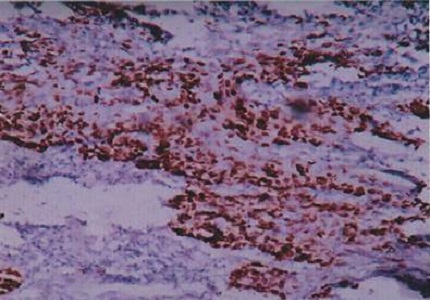The use of molecular markers (Ki67 & p53) in premalignant and malignant cervical neoplasms
Abstract
Introduction: Cervical cancers are the second most frequent type of cancer in females. It develops from premalignant to invasive stages in a multistep process of carcinogenesis. The differentiation between cervical intraepithelial neoplasia III (CIN III) and early squamous cell carcinoma (SCC) of the cervix could be difficult to diagnose in certain situations unless we see the invasion. The objective of the study was to determine the expression of p53 & Ki67 in CIN and cervical cancers and its correlation with grading and differentiation of cervical cancers with special emphasis on whether the use of Ki67 & p53 markers could help in differentiating CIN III from early SCC.
Material and Methods: A prospective study on 90 cases of cervical biopsies, including- cases of : chronic cervicitis (40), CIN III (19) and invasive carcinoma (31). All cases were evaluated by immunohistochemistry using Ki67 & p53 monoclonal antibodies.
Results: Both Ki67 & p53 showed higher expression in CIN III and invasive cervical carcinoma than chronic cervicitis with statistically significant difference p<0.01 and p<0.001 respectively. High significant difference of p53 & Ki67 expression was found between patients with CIN III and invasive cervical carcinomas. There was a clear trend for increasing number of cases with positive Ki67 & p53 index with increasing grades of cervical cancer.
Conclusion: Ki67 & p53 showed increased expression from CIN III to SCC and it may be helpful adjunct in differentiating these two lesions. These markers could be used as biomarkers in the evaluation of the proliferative activity and progressive potential of dysplastic and neoplastic changes.
Downloads
References
2. World Health Organisation (Feb 2006). Fact Sheet No. 297: 376-12. [PubMed]
3. Bauer HM, Hildesheim A, Schiffman MH, Glass AG, Rush BB, Scott DR, Cadell DM, Kurman RJ, Manos MM. Determinants of genital human papillomavirus infection in low-risk women in Portland, Oregon. Sex Transm Dis. 1993 Sep-Oct;20(5):274-8. [PubMed]
4. Psyrri A, DiMaio D. Human papillomavirus in cervical and head-and-neck cancer. Nat Clin Pract Oncol. 2008 Jan;5(1):24-31. [PubMed]
5. de Araujo Souza PS, Villa LL. Genetic susceptibility to infection with human papillomavirus and development of cervical cancer in women in Brazil. Mutat Res. 2003 Nov;544(2-3):375-83.
6. Pandeli R, Cozma GL, Anton C, Neyara A. Tumour Angiogenesis as a predictor in Cervix carcinoma. J Prev Med. 2005; 13 (3-4): 72-77.
7. Panjkovic M, Ivkovic-Kapicl T. Ki67 expression in squamous intraepithelial lesions of the uterine cervix. Arch Oncol. 2006; 14 (1-2): 23-25.
8. Bulten J, van der Laak JA, Gemmink JH, Pahlplatz MM, de Wilde PC, Hanselaar AG. MIB1, a promising marker for the classification of cervical intraepithelial neoplasia. J Pathol. 1996 Mar;178(3):268-73.
9. Konish I, Fujii S, Nonogaki H, Nanbu Y, Iwai T, Mori T. Immunohistochemical analysis of estrogen receptors, progesterone receptors, Ki67 Antigen and HPV DNA in normal and neoplastic epithelia of uterine cervix. Cancer. 1991 sept 15; 68 (6) : 1340-50.
10. Finlay CA, Hinds PW, Tan TH, Eliyahu D, Oren M, Levine AJ. Activating mutations for transformation by p53 produce a gene product that forms an hsc70-p53 complex with an altered half-life. Mol Cell Biol. 1988 Feb;8(2):531-9. [PubMed]
11. Storey A, Thomas M, Kalita A, Harwood C, Gardiol D, Mantovani F, Breuer J, Leigh IM, Matlashewski G, Banks L. Role of a p53 polymorphism in the development of human papillomavirus-associated cancer. Nature. 1998 May 21;393(6682):229-34.
12. Tan GC, Sharifa NA, Salwati S, Shiran MS, Hatta AZ. NaHo2 Immunochemical study of p53 expression in premalignant and malignant cervical neoplasms. Med and Health. 2007; 2 (2): 125-132.
13. Eun Ji Nam, Jae Wook Kim, Jong Wook Hong et al. J Gynecol Oncol. 2008 September: 1 (3).
14. Geok Chin Tan, Noor Akmal Sharifan, Mohd Sidik Shiran, shuib Salwati, Ahmad Zailani Hatta, Hock oon Paul-Ng. Ki67 and p53 for distinguishing CIN 3 and cervical squamous cell carcinoma. Asian Pacific Journal of Cancer Prevention. Vol 9, 2008; pg 781-783.
15. Huang LW, Chou YY, Chao SL, Chen TJ, Lee TT. p53 and p21 expression in precancerous lesions and carcinomas of the uterine cervix: overexpression of p53 predicts poor disease outcome. Gynecol Oncol. 2001 Nov;83(2):348-54. [PubMed]
16. ACOG Committee on Practice Bulletins--Gynecology. ACOG Practice Bulletin no. 109: Cervical cytology screening. Obstet Gynecol. 2009 Dec;114(6):1409-20. doi: 10.1097/AOG.0b013e3181c6f8a4. [PubMed]
17. Jha AK, Jha J, Bista R, Basnet B, Kandel P, Lama G, Banthia P, Thakali K. A scenario of cervical carcinoma in a cancer hospital. JNMA J Nepal Med Assoc. 2009 Jul-Sep;48(175):199-202. [PubMed]
18. Kanupriya Gupta, Kiran Alam, Veen Maheshwari, Roobina Khan Jand, Rajyashri Sharma. Apoptotic Index and MIB 1 antibody expression in premalignant and malignant lesions of uterine cervix. Gynecol Obs. 2013: 173. Doi 10; 4172/2161-0932.1000173.
19. Natalia Gaspar Munhoz, Damaris Aparecida Rodrigues, Juliang Ligveireds Pedregosa, Juliana Olsen Rodrigues et al. The open pathology Journal. 2009; 3: 10-17.
20. Oka K, Suzuki Y, Nakano T. p27 and p53 expression in cervical squamous cell carcinoma patients treated with radiation therapy alone. Radiotherapeutic effect and prognosis. Cancer. 88; 2766-2773.



 OAI - Open Archives Initiative
OAI - Open Archives Initiative


